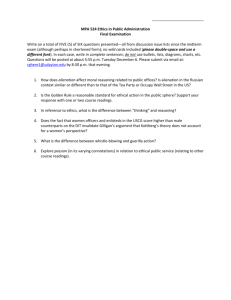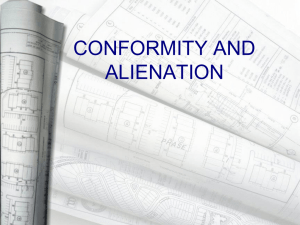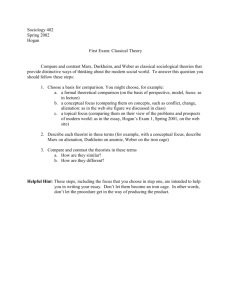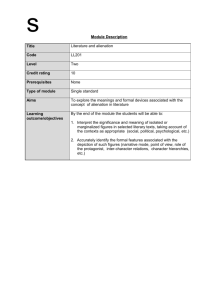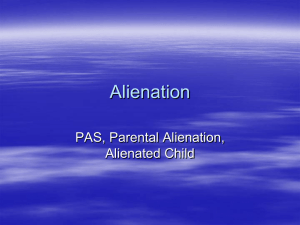Anderson, Barry D. School Bureaucratization and Alienation from
advertisement
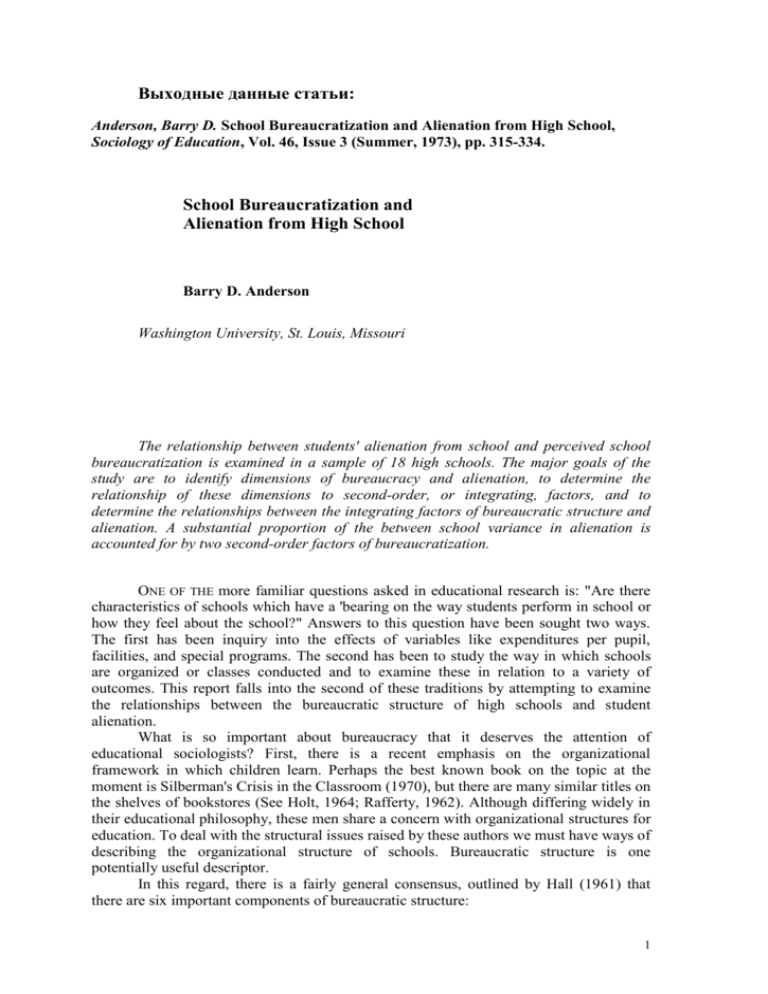
Выходные данные статьи: Anderson, Barry D. School Bureaucratization and Alienation from High School, Sociology of Education, Vol. 46, Issue 3 (Summer, 1973), pp. 315-334. School Bureaucratization and Alienation from High School Barry D. Anderson Washington University, St. Louis, Missouri The relationship between students' alienation from school and perceived school bureaucratization is examined in a sample of 18 high schools. The major goals of the study are to identify dimensions of bureaucracy and alienation, to determine the relationship of these dimensions to second-order, or integrating, factors, and to determine the relationships between the integrating factors of bureaucratic structure and alienation. A substantial proportion of the between school variance in alienation is accounted for by two second-order factors of bureaucratization. ONE OF THE more familiar questions asked in educational research is: "Are there characteristics of schools which have a 'bearing on the way students perform in school or how they feel about the school?" Answers to this question have been sought two ways. The first has been inquiry into the effects of variables like expenditures per pupil, facilities, and special programs. The second has been to study the way in which schools are organized or classes conducted and to examine these in relation to a variety of outcomes. This report falls into the second of these traditions by attempting to examine the relationships between the bureaucratic structure of high schools and student alienation. What is so important about bureaucracy that it deserves the attention of educational sociologists? First, there is a recent emphasis on the organizational framework in which children learn. Perhaps the best known book on the topic at the moment is Silberman's Crisis in the Classroom (1970), but there are many similar titles on the shelves of bookstores (See Holt, 1964; Rafferty, 1962). Although differing widely in their educational philosophy, these men share a concern with organizational structures for education. To deal with the structural issues raised by these authors we must have ways of describing the organizational structure of schools. Bureaucratic structure is one potentially useful descriptor. In this regard, there is a fairly general consensus, outlined by Hall (1961) that there are six important components of bureaucratic structure: 1 (1) (2) (3) (4) (5) (6) a division of labor based upon functional specialization, a hierarchy of authority, a system of rules governing the rights and duties of members, a system of procedures for dealing with work situations, an impersonality in inter-personal relationships, and a procedure for selecting and promoting participants on the basis of their technical competence. These components refine the concept of bureaucracy and enable its application to schools. Another reason bureaucracy deserves attention is that it may be related to pupil achievement in, and feelings about, school. DeCharms (1972) has shown that achievement is related to feelings of power and control in students. Piaget (1932) has mentioned the critical role played by feelings of control and power in motivating students to learn. Coleman et al. (1966) in their study of American high schools, found that a question dealing with student feelings of power and control was one of the most potent predictors of achievement: those students who felt powerful also were high achievers. If, as literature suggests, bureaucracy affects feelings of power and control, then it also may be a determinant of academic success. Last, and most important, if the first two points are correct, is the fact that bureaucratic structure is a variable which can be manipulated by school administrators. Unlike explanations of poor achievement based on the social origins of students or on their personalities or on their intelligence, bureaucratic structure may give us an explanation which provides more than a label for a problem. After all, it doesn't do much good to know that students who have a low I.Q. do poorly in school unless we know how to raise I.Q. The great value of studies of bureaucracy is that they may help isolate components of school structure which then can be manipulated to achieve certain goals of education. Like bureaucracy, alienation is an interesting concept for educational sociologists. According to Seeman (1959) the term refers to at least five distinct components: (1) Powerlessness: A low expectancy of ability to determine or control outcomes or reinforcements sought in the school. (2) Meaninglessness: A low expectancy of ability to make satisfactory predictions about the future outcomes of behavior in the school. (3) Misfeasance: (Cf. Seeman's normlessness) An expectation that the use of means which are prohibited by school authorities is necessary in order to attain goals desired by the student. (4) Futility: (Cf. Seeman's isolation) Assignment of low reward value to goals and beliefs that are highly valued by school authorities. (5) Self-estrangement: Participation in school and school-related activities is based largely upon anticipation of future rewards rather than upon rewards inherent to participation such as pleasure or satisfaction. These components should be intrinsically interesting, for what educator wants his students to feel their school work is meaningless, that it was necessary to cheat to be successful, or that what is learned in school is of little value? Indeed, these aspects of alienation seem to contain the essence of many of the things we are trying to help children avoid through education. Whether or not these dimensions are of intrinsic interest to educators is moot. The concept does subsume the notion of powerlessness which, as mentioned above, may be closely related to pupil achievement. That point should be of interest to educators regardless of their philosophical bent. Earlier efforts fail to provide a satisfactory test of the hypothesis that individual 2 alienation may be explained by a contextual variable such as bureaucratization. Studies by Bonjean and Grimes (1970), Aiken and Hage (1966), Neal and Seeman (1964), Pearlin (1962), and Argyris (1959) show alienation related to some of the characteristics of bureaucratic organization. In a school setting, Kolesar (1967) found pupil powerlessness to be related to type of bureaucratic organization. On the other hand, Byles (1967: 21) found that social control (which is similar to the control aspects of bureaucratization) and alienation ". . . are two co-existing but separate phenomena, each operating independently of the other." The major purpose of the study reported here is to provide a more satisfactory test of the relationship between organizational bureaucratization and alienation from school by attempting to account for variance in the alienation scores of students in terms of the degree of bureaucratization found in their schools. To do this data were collected in 18 secondary schools located in the province of Ontario, Canada, during the period December-March, 1968-1969. The sample of schools was random, but stratified on the basis of school and school district size and curriculum (academic, vocational composite). Information about bureaucratic structure, alienation, and personal backgrounds of students was collected from all grade ten pupils in each school, giving an N of 3,792. Since variables other than organizational bureaucratization are 'thought to cause alienation, the problem becomes one of determining the importance of organizational bureaucratization over and above the effects of other possible causes. Symbolically the problem may be expressed as follows: (1) A=B+C where A == Alienation. B = School bureaucratization. C = A set of variables thought to cause alienation. Assuming appropriate measures, a regression model seems an obvious means of examining this problem. Indeed, just such a model is used, but before it can be specified, a digression into the extent and nature of alienation and bureaucratization in the sample is required. Alienation Alienation has been defined as "... a general syndrome made up of a number of different objective conditions and subjective feeling-states . . ." (Blauner, 1964: 15). In a similar vein, McClosky and Schaar (1965: 40) state that Anomy ". . . may be only one of many symptoms expressing a negativistic, despairing outlook both on one's own life and on the community in which one lives." Clearly, the implication of such thinking is that there may be a number of variables which vary together and compose a syndrome which may be labelled alienation. Alienation, conceptualized in this manner, is somewhat like Spearman's "g", in that it is a general factor or integrating concept which is composed of more specific factors. In contrast to these viewpoints, Seeman (1959:783) argues that there are ". . . five basic ways in which the concept of alienation has been used." These are logically distinguishable but may be empirically related. Dean (1961:754) concurs with Seeman noting that ". . . sometimes the same writer includes several nuances of meaning." Empirical evidence in the form of factor analytic studies by Neal and Rettig (1963; 1967), Struening and Richardson (1965), Besag (1966), and Kolesar (1967); as well as in the form of correlational studies by Dean (1961) and Middleton (1963) support Seeman's contention that alienation is really multi-dimensional. However, with the sole 3 exception of Neal and Rettig's 1967 study, there appear to be no attempts to reveal the extent to which the factors, or dimensions, of alienation co-vary. This is an important point, for if the dimensions co-vary, model (1) will be suitable as a test of an alienationbureaucracy relationship, since it would be appropriate to regard alienation as an integrating concept under which the dimensions were subsumed. For this study alienation is defined along lines suggested by Seeman, with the exception of minor changes in terminology designed to obtain greater clarity; and with the proviso that school is deemed to be the focus of alienation. For example, students were queried about their feelings of powerlessness in school as opposed to their being generally powerless (Cf: Clark, 1959). Items such as the following were used: (1) (2) (3) (4) (5) Powerlessness: My teachers generally do what they want to do, no matter what I say. Meaninglessness: School doesn't help me figure out what to do with my life. Misfeasance: Cheating is the only way for me to get what I want out of school. Futility: I have better things to do with my time than fool around with school clubs. Self-estrangement: I would prefer to be out working than to remain in school. Bureaucracy The classic formulation of the bureaucratic model is by Weber (1946: 196-204); his model is applicable to all types of administrative tasks and to many different types of organizations. His work has led to a variety of attempts to refine the bureaucratic model and to use it in empirical research. These have raised the question of how many and which of Weber's bureaucratic characteristics or dimensions are essential to bureaucratic structure. There is considerable confusion in the literature about this point, beginning with Weber himself. Pugh et al. (1963: 295) find twenty-six different characteristics in his formulation. Yet, despite the profusion of possibilities, both Heady (1959: 515) and more importantly Hall (1961:6 -7) conclude that there is substantial agreement on the basic elements. With this as his rationale, Hall (1961) was able to construct scales to measure perceptions of six of the "basic" dimensions: hierarchy of authority, specification, rules, procedural specifications, impersonality, and technical competence. As was the case with alienation, if model (1) is to be appropriate, the dimensions of bureaucratic structure must be parts of an integrative concept. If they are not, it is improper to treat bureaucracy as the sum of its parts. There is more evidence on this point than was the case with alienation; several studies of bureaucracy (Hall, 1966; Kolesar, 1967; Punch, 1967) have attempted to determine the extent to which these dimensions covary. Using a variety of techniques all have arrived at a similar conclusion – the dimensions seem to be measuring more than one underlying concept, for they do not vary together. The point is largely academic at this point since dimensionality of the concept is an empirical question which can be answered in the data analysis. Drawing upon Hall, Kolesar (1967), and Punch (1967), items such as the following were constructed for each of the six dimensions: (1) Specialization: I take a large number of different courses. (2) Procedural Specifications: I follow a lot of routine school regulations about how school work is to be done. (3) Hierarchy of Authority: School officials frequently exercise their right to tell me what to do. (4) Rules: I am careful not to violate school rules which regulate my personal conduct. (5) Technical Competence: My chances of success in this school depend almost entirely on my ability. (6) Impersonality: My relationships with teachers are formal and impersonal. 4 Instrumentation The instruments used to measure alienation and bureaucratization consisted of Likert-type items with five possible responses ranging from strongly agree through undecided to strongly disagree. The questions were selected in two stages. First, a pool of 360 items was divided randomly among six questionnaires of sixty items each. These were administered to between 25 and 30 grade ten students of varying ability. The students were given simple definitions of the eleven concepts the items were intended to measure and were asked to match each item with its appropriate definition. If the fraction of correct choices was not larger than that which could be expected by chance, the item was discarded. This procedure eliminates items which are ambiguous to students; it also tends to insure that the measures of bureaucratic structure and student alienation are not merely two different measures of the same concept. The 110 remaining bureaucracy items were administered to 25 students in a school where one of the explicit goals of the staff and students was the removal of bureaucratic characteristics. They also were given to 67 students in a private, bureaucratically organized school for boys. Fifty-seven items which differentiated (P < .05) between the two schools were retained for the final scale. The 104 remaining alienation items were administered to two groups of adolescents. The first of these was a class of 27 grade eleven students all of whom were (1) more heavily involved in extra-curricular activities, (2) taking one or more extra academic courses, (3) attending school even though they were legally free to leave, and (4) regarded by their teachers as students who truly enjoyed school. The second group of youngsters was drawn from a boarding house established to aid alienated youths and a church drop-in center located in an area where alienated youths congregate. Staff members of the drop-in center and of the boarding house identified some of the most alienated youths in the two centers and 15 of these youths, all but one of whom had dropped out of school, responded to the items. The 44 items which differentiated between the two groups (P < .05) were retained for the final scale. Preliminary Analysis of Bureaucracy and Alienation Data1 At this point it is possible to examine four hypotheses which must precede an examination of model (1). They are: HI. Factors identifiable as Hierarchy of Authority, Rules for Personal Conduct, Procedural Specifications, Impersonality, Technical Competence and Specialization will emerge from an Image Analysis2 of the correlations between the items intended as measures of school bureaucratization. H2. A factor identifiable as Bureaucratic Structure will emerge from an Image Analysis of the correlations between the dimensions of bureaucratic structure revealed in the test of hypothesis one. H3. Factors identifiable as Powerlessness, Meaninglessness, Misfeasance, Futility, and Self-estrangement will emerge from an Image Analysis of the correlations between items intended as measures of student alienation from school. H4. A factor identifiable as Alienation from School will emerge from an Image Analysis 1 Alienation and bureaucracy items available from the author upon request. Image analysis is a desirable factor analytic technique for two reasons: an attempt is made to remove error variance from the correlation matrix before factoring and it allows exact computation of image scores based on the reduced correlation matrix. The latter point is particularly important because of the heavy reliance placed on factor scores later in this analysis. Guttman (19S3) and Kaiser (1958, 1963) discuss these and other advantages of Image Analysis in more detail. 2 5 of the correlations between dimensions of alienation revealed in the test of hypothesis three. HI. The 57 items of the Bureaucracy Scale were subjected to an Image Analysis and nine factors with eigenvalues greater than one were found. The last three of these had no loadings greater than .24 as did 23 items. These factors and items were dropped from subsequent analyses on the grounds that they were uninterpretable. The first six factors were then rotated to a Promax criterion (Hendrickson and White, 1964) after which they accounted for 25.7% of the total variance in the 34 item scale and 93.2% of the common variance. The factors generally correspond in meaning to dimensions of bureaucratic structure. They are named as follows: (1) Rules and Regulations, (2) Hierarchy of Authority, (3) Impersonality, (4) Subject Matter Specialization, (5) Centralization of Control, and (6) Technical Competence. These results were as expected with two exceptions: two hypothesized dimensions. Rules for Personal Conduct and Procedural Specifications combined into a dimension called Rules and Regulations and the hypothesized dimension Hierarchy of Authority contained a group of items measuring Centralization of Control. H2. Since the Promax rotation used to test hypothesis one yields correlated dimensions of bureaucratic structure, it is possible to seek an integrating second-order factor through Image Analysis of the 6x6 matrix of correlations between the dimensions. This analysis yields three factors with eigenvalues greater than one but when rotated to the Varimax criterion, factor three has no loadings greater than .24 and is discarded. The remaining two factors account for 47% of the total variance in the dimensions and 95% of the common variance. Factor one is defined by the dimensions of Hierarchy of Authority and Impersonally (the factor also has high loadings on dimensions of Specialization and Technical Competence, but so does factor two). Since the factor seems to measure reliance on formal status as a means of handling interpersonal relations it is named Status Maintenance. Factor two seems to measure the extent to which people regard their behavior as controlled through rules and centralized decision-making and is named Behavior Control. In sum, hypothesis two must be rejected since a single integrating factor was not found. However, the two factors which were found, taken together parsimoniously describe an individual's perceptions of school structure since the co-ordinates which locate any school on a two-dimensional "map" of bureaucracy are given by the two image scores. In terms of the relationship between bureaucratic structure and dependent 'Variables such as alienation rejection of hypothesis two simply means that the factors of bureaucratization must be studied in conjunction wit each other. TABLE 1 Correlations between the Dimensions (First-Order Factors) of Bureaucratic Structure Dimensions 1. Rules and Regulations 2. Hierarchy of Authority 3. Impersonality 4. Subject Matter Specialization 5. Centralization of Control 6. Technical Competence 1 1.00 0.03 0.34 –0.35 0.63 0.56 2 3 1.00 0.65 –0.47 –0.01 0.45 1.00 –0.56 0.22 0.36 4 5 6 P .01 =0.23 P .05 =0.16 1.00 –0.28 –0.26 1.00 0.35 1.00 6 TABLE 2 Second-Order Factors of the Dimensions of Bureaucratic Structure Dimensions Unrotated Factor Loadings 1 2 3 Varimax Rotated Factor Loadings 1 2 3 Communalities1 1. Rules and Regulations –0.57 0.48 –0.01 0.16 0.72 0.07 0.55 2. Hierarchy of Authority –0.58 –0.46 0.06 0.72 –0.02 0.19 0.56 3. Impersonality –0.67 –0.23 –0.10 0.68 0.23 0.04 0.51 4. Subject Matter Specialization 0.58 0.10 0.17 –0.54 –0.27 0.05 0.37 5. Centralization of Control –0.43 0.44 –0.07 0.08 0.61 –0.01 0.38 6. Technical Competence –0.63 0.12 0.21 0.38 0.46 0.31 0.45 Variances 2.03 0.71 0.09 1.45 1.23 0.14 2.82 Eigenvalues 6.46 3.43 1.52 … … … … 1 These also represent lower-bound estimates of the reliabilities of the dimensions (Harman, 1960: 15). TABLE 3 Correlations between the Dimensions (First-Order Factors) of Student Alienation from School Dimensions 1. Self-estrangement 2. Misfeasance 3. Powerlessness 4. Futility of Extra-curricular Activities 5. Meaninglessness P .01 = 0.23 P .05 = 0.16 N = 3792 1 1.00 0.75 0.72 0.77 0.873 2 3 4 5 1.00 0.77 0.73 0.83 1.00 0.74 0.78 1.00 0.76 1.00 H3. The 44 items of the Alienation scale were subjected t an Image Analysis and five factors with eigenvalues greater than one found. These correspond to the dimensions of alienation (1) Self-estrangement, (2) Misfeasance, (3) Powerlessness, (4) Futility of Extra-Curricular Activities, and (5) Meaninglessness. (Se Anderson (1970 or 1971a) for tabular results of the analyses performed to test hypotheses one through four.) The only major restriction of the original hypothesis is the change in meaning attached to Futility. Six items were discarded because they ha no factor loadings greater than .24. The five factors were rotated to the Promax criterion; the rotated factors account for 38.9% of the total variance in the seal and 91.4% of the common variances H4. The 5x5 matrix of correlations between the dimensions of alienation was subjected to an Image Analysis which yielded a single factor accounting for 72.4% of the total variance in the dimensions and 99.7% of their common variance. Thus it is reasonable to assert that the dimensions of alienation are indeed aspects of single, integrating concept. 7 TABLE 4 Second-Order Factors of the Dimensions of Student Alienation from School Unrelated Factor Loadings Dimensions 0.87 -0.06 0.00 1. Self-estrangement 0.84 0.04 0.00 2. Misfeasance 0.82 0.06 0.00 3. Powerlessness 0.02 0.00 4. Futility of Extra-curricular Activities 0.81 0.91 0.02 0.00 5. Meaninglessness Variances 3.62 0.01 0.00 Eigenvalues 17.62 1.22 1.01 Communalities 0.76 0.72 –0.67 0.66 0.83 3.63 Summary Analysis to this point has shown that for this sample it is appropriate to regard alienation as an integrating concept under which the five dimensions described by Seeman may be subsumed. A parallel analysis has shown that the dimensions of bureaucratic structures not co-vary and that two integrating concepts called Behavior Control and Status Maintenance are needed to describe the data. In addition, a series of one-way analyses of variance (see Anderson, 1970: 128, 134, 207 and 226) show that each item, dimension and integrating factor differentiates significantly between schools. Also, the communalities shown in Tables 2 and 4 are lower bound estimates of the reliabilities of the dimensions of bureaucratic structure and alienation respectively (Harman, 1960: 15) and are adequate for the purposes of this study. The Bureaucracy-Alienation Relationship Because there are two aspects of bureaucratic structure, model (1) must be respecified as: (2) A = SM + BC + C where A = Alienation. SM = Status Maintenance. BC = Behavior Control. C == A set of variables thought to cause alienation. The analyses of bureaucracy and alienation in the sample enables image scores to be computed for each subject for A, SM, and BC. But what is to be done about the control variables? This is important, for any relationships between school bureaucratization and student alienation may be confounded by variables known to be related to alienation. There are a number of these: political apathy (Dean, 1960; Erbe, 1964; Rosenberg, 1956), lack of access to life goals (Mier and Bell, 1959), low educational achievement (Middleton, 1963), low social class (McClosky and Schaar, 1965; Middleton, 1963; Gold, 1960; Erbe, 1964), low social class identification (Mier and Bell, 1959; Mizruchi, 1960), low degree of social participation (Mizruchi, 1960; Neal and Seeman, 1964; Pearlin, 1962; Clark, 1959; Erbe, 1964), membership in work-centered groups (unions) (Neal and Seeman, 1964), preemptory exercise of official authority (Pearlin, 1962), large hierarchical discrepancies between manager and managed (Pearlin, 1962), lack of promotions (Pearlin, 1962), high expectations of financial reward (Mizruchi, 1960), low satisfaction with the organization (Clark, 1959), and low degrees of relevant knowledge (Clark, 1959; Seeman, 1963; Neal and Seeman, 1964). 8 The more important of these: sex, socio-economic status, social participation, membership in school-oriented groups and degree of past success are measured to enable statistical control over their effects on the bureaucracy-alienation relationship. Socio-economic status was measured using the seven broad categories of the Blishen Scale (Blishen, 1965), a measure of SES developed for coding Canadian occupations. Participation was measured using modified versions of the Chapin Social Participation Scale (See Miller, 1964: 209-212) for both school-related and extracurricular activities. Since all students were in grade ten, age per se becomes unimportant as a cause of alienation, but it serves as a proxy for success. As the last step prior to specifying a regression model, the sample was split in half and an average score computed for each school on each factor of bureaucratic structure using one of the halves.3 The regression model to test a relationship between bureaucracy and alienation can now be specified as: (3) A = SM + BS + SP + ASP + Age + Sex + SES where A = Alienation scores for each student derived from second-order Image Analysis. High scores indicate high alienation. SM = Status Maintenance scores for each school derived from second-order Image analysis and averaging procedure. High scores indicate frequent attempts at status maintenance. BS = Behavior Control for each school derived from second order Image Analysis and averaging procedure. Low scores indicate frequent observance of controls by students. SP = Social participation in school activities for each student. High scores indicate high participation. ASP = Social participation in out-of-school activities for each student. High scores indicate high participation. Age = Age of each student in years. Sex = For each student scored 1 if female, zero if male. SES = Socio-economic status from the Blishen Scale. Low scores indicate high social class. Means, standard deviations, and correlations between the variables involved in the model are shown in Table 5; the necessary regression equations are shown in Table 6. Table 6 may be interpreted by noting that in equation 6.1 a unit increase in Status Maintenance over the sample (which, because of scaling, would be equivalent to decreasing the number of attempts at keeping social distance) should result in a decrease of .615 units in the average alienation score over the sample. A unit increase in Behavior Control over the sample (because of scaling, this would mean a decrease in observance of rules) would result in a .552 unit increase in average alienation. In short, the relationship between bureaucratization and alienation is as hypothesized: increasing presence of bureaucratic characteristics seems to be associated with increasing alienation. 3 The other half is used later to test the bureaucracy alienation relationship. The sample was split in order to reduce the possibility that alienation scores could be contaminated by misperceptions of alienated people (see Davids, 1955). Tannenbaum and Bachman (1964) describe other ways of partialling individual effects out of tests for organizational variables. 9 TABLE 5 Means, Standard Deviations, and Correlations for Analysis of Bureaucracy Alienation Relationship N – 1890 1 2 3 4 5 1. Alienation 1.00 2. Status Maintenance * –0.12 1.00 3. Behavior Control * 0.19 –0.09 1.00 4. Number of School –0.21 –0.02 0.02 1.00 Organizations 5. Number of Non–0.11 0.00 0.02 0.41 1.00 School Organizations 6. Age 0.10 –0.02 –0.02 –0.16 –0.09 7. Sex ** –0.17 0.02 –0.02 0.00 –0.03 8 Socio–Economic –0.10 –0.02 –0.39 –0.05 –0.02 Status –0.01 –0.32 –0.14 1.31 1.10 Means 0.99 0.16 0.31 2.00 1.41 Standard Deviations * These are school means computed from the second half of the sample. ** Sex is scored 1 for a female, zero for a male. 6 7 8 1.00 –0.08 1.00 0.01 0.06 1.00 15.43 2.14 0.52 0.50 3.77 1.91 The size safe 'the squared multiple correlations (RSQ's) reported in Table 6 is quite small. Equation 6.1 accounts for the most variance and hence is the most accurate predictor of alienation. The control variables (equation 6.2) account for the next largest segment of the variance, while the school variables (equation 6.3) are the least accurate, accounting for only 4.6% of the variance in alienation. These findings indicate that a good deal of variance in individual student alienation from school is explained by factors other than school bureaucratization and the control variables. In other words, the small RSQ's mean that it is impossible to make accurate predictions about an individual student's alienation from school with these variables. Nevertheless, the trend relating bureaucratization to alienation in general is strong and ought not be ignored.4 By partitioning the variance into that accounted for by the controls alone, the factors of bureaucratization alone, and overlap between the controls and bureaucratization, the degree to which school characteristics are confounded with the controls is shown. (See Mood, 1971.) In this case there is very little overlap between the two sets of variables. In other words, the effect of school structure is over and above the effect of students' characteristics. One last point needs attention. Since school bureaucratization at best explains only 4.6% of the variance in alienation from school, can the concept be said to be useful? Might there not be other characteristics of schools which led to alienation? In order to answer this question a regression analysis was performed using a series of eighteen dummy variables for each school to predict alienation. The model is: (4) A = S1 + S2 + S3 + ... + S18 where A = Alienation. Sn == one if in school n, zero otherwise. Model (4) captures all variance in alienation attributable to differences between schools. The model has an RSQ of .064, meaning that differences between schools account for a maximum of only 6.4% of the variance in alienation from school. Given this result the components of bureaucratic structure used in the study seem to perform quite well as descriptors of schools, for they account for 71.9% of the between schools variance 4 Large squared multiple correlations would be surprising, as they would mean that patterns of school organization had very similar effects on all students. This hardly would meld with other research and common sense knowledge about the impact of school on students. 10 in alienation (4.6 / 64% × 100%). TABLE 6 Regression Equations Predicting Alienation from Bureaucracy and Control Variables Status School Non-School Behavior Maintena OrganizaOrganizaControl2 nce2 tions tions Equation # RSQ1 6.1 0.124 –0.615 +0.552 –0.096 6.2 0.087 … … 6.3 0.046 –0.609 +0.582 Age Sex SES Constant –0.028 +0.024 –0.314 –0.019 –0.103 –0.095 –0.025 +0.023 –0.318 –0.055 +0.152 … … … … … –0.125 Variance accounted for by all variables=12.4%. Variance accounted for solely by controls=7.8% (12.4% – 4.6%). Variance accounted for solely by bureaucratization=3.7% (12.4% – 8.7%). Variance accounted for by overlap between bureaucratization and controls =0.9% (12.4% – [3.7%+7.8%]). 1 All squared multiple correlations are significantly greater than zero (p<0.01). 2 All beta weights for bureaucratization are statistically significant (p<0.01). An unanswered question deals with whether or not a lower level of aggregation such as the classroom might not have provided a better explanation of alienation than school level variables. Since the students who took part in this study were moved through a number of rooms during a school day, it is impossible to answer the question. Research presently under way in a sample of elementary schools will attempt to get at the problem by examining students who are in the same classroom for nearly all of the school day. In this sample, it will be possible to use the classroom as a unit of analysis and thus to get directly at differences between teachers. Conclusions Evidence provided by this study suggests that in the case of schools it is appropriate to regard bureaucratic structure as composed of two main components: Status Maintenance and Behavior Control. While it is possible that the structure revealed in this study might not be applicable to organizations other than schools, the model used offers promise as a means of answering the question "How many, and which, dimensions of bureaucratic structure are important?" Alienation from school is composed of five empirically distinguishable dimensions. These are correlated and load on a single second-order factor, indicating that they comprise parts of an integrating concept. The study thus provides strong support for the work of Seeman and indicates that the dimensional model of alienation might be applied profitably to studies of alienation from foci other than schools. The contextual measures of bureaucratization account for only about 4.6% of the variance in alienation from school, calling attention to the possibility that theories which locate the source of alienation in work environments may be incorrect. While there are a number of studies of these theories, none seems to account for a great deal of variance in alienation. Further, the most successful studies seem to tie specific aspects of bureaucratic structure (e.g., rules and regulations) to specific aspects of alienation (e.g., powerlessness). In this regard, the regression equation, and not the amount of variance explained, seems to be the appropriate means of seeking school effects. In fact, this is precisely what Blalock means when he notes that ... if there is any degree of assurance that in effect manipulations have been made primarily in 11 terms of the independent variable, then comparisons involving slopes will ordinarily be more meaningful than those using correlation coefficients. . . . Basically, our interest in correlation coefficients in these comparisons should be mainly to help us determine the degree of accuracy in our estimates of slopes. (Blalock, 1964, p. 126) Given this interpretation, then, one would assume that the school effects found in these data were significant, but that they could not be expected to be the same for all individuals in each school. Such an interpretation seems much more reasonable than the dismissal of school effects entirely on the grounds that they explain a trivial amount of the variance in alienation. In fact, the amount of variance attributable to school effects is very dependent upon the units of analysis selected for a study, while regression weights are apparently much more stable across levels of aggregation. Despite the low squared multiple correlations, the measure of bureaucratic structure does account for a large proportion of the variance in alienation attributable to differences between schools. Thus, the notion of bureaucratic structure seems promising as a way of describing differences between schools. For the practitioner, linking the research to deCharms' and Coleman's findings associating student feelings of power and achievement suggests that school administrators hold a key to pupil achievement in that less bureaucratic modes of school organization may produce higher levels of pupil achievement. This is a tempting hypothesis since students of low socio-economic status (where grades often are low) seem to attend more highly bureaucratized schools than do students of high status (Anderson 1971b). This raises the interesting possibility that the poor achievement of these pupils in school may be due partially to the way that schools are run, and not just to deficiencies in their background as much current literature would suggest. Administrators may play a key role; earlier research (Punch, 1967) has shown school bureaucratization to be related to the way in which school principals behave. Thus principals who choose to do so might be able to reduce student alienation from school by modifying the organizational structure of their schools and classrooms. One final point. There is a negligible correlation between student and teacher perceptions of school bureaucratization (Anderson, 1971c), suggesting that faculty may not realize student views of school organization. They must, then, take pains to assess students' viewpoints, since student perceptions are most likely to be related to student conduct and attitudes toward the school. References Aiken, M., and J. Hage. 1966 "Organizational alienation: A comparative Sociological review 31 (August): 497–507. analysis." American Anderson, B. D. 1970 "Bureaucratization and alienation: An empirical study in secondary schools." Unpublished Ph.D. Dissertation. The University of Toronto. 1971a "The bureaucracy – alienation relationship in secondary schools." Research in Education ERIC Document Reproduction, Bethesda, Md. ED 053 445. 1971b "Socio-economic status of students and school bureaucratization." Educational Administration Quarterly 7 (Spring): 12–23. 1971c "Bureaucracy in school and student alienation." The Canadian Administrator 11 (December). Argyris, C. 12 1959 "The individual and the organization: An empirical test." Administrative Science Quarterly 4 (September): 145–167. Besag, F. P. 1966 Alienation and Education; An Empirical Approach. Buffalo, New York: Hertillon Press. Blalock, H. M. 1961 Causal Inferences in Nonexperimental Research. Chapel Hill: The University of North Carolina Press. Blauner, R. 1964 Alienation and Freedom. Chicago: University of Chicago Press. Blishen, B. R. 1965 "The construction and use of an occupational class scale." In B. R. Blishen, F. E. Jones, K. D. Naegele and J. Porter (eds.). Canadian Society: Sociological Perspectives. Toronto: Macmillan of Canada. Bonjean, C. M., and M. D. Grimes. 1970 "Bureaucracy and alienation: A dimensional approach." Social Forces 48 (March): 365–373. Byles, J. A. 1967 Clark, J. P. 1959 "Alienation and social control." Interim Research Project on Unreached Youth (mimeo.). "Measuring alienation within a social system." American Sociological Review 24 (December): 849–852. Coleman, J. S., et at. 1966 Equality of Educational Opportunity. Washington: United States Government Printing Office. Davids, A. 1955 Dean, D. G. 1960 1961 "Alienation, social appreciation, and ego structure." Journal of Consulting Psychology 19 (February): 20–27. "Alienation and political apathy." Social Forces 38 (March): 185–189. "Alienation: Its meaning and measurement." American Sociological Review 26 (October): 753–758. deCharms, R. 1972 "Personal Causation Training in the Schools," Journal of Applied Sodal Psychology, 2 (April–June): 95–113. Erbe, G. T. 1964 Gold, D. 1962 "Social involvement and political activity: A replication and elaboration." American Sociological Review 29 (April): 198–215. "Independent causation in multivariate analysis: The case of political alienation and attitude to a school bond issue." American Sociological Review 27 (February): 85–87. Guttman, L. 13 1953 Hall, R. A. 1961 "Image theory for the structure of quantitative variates." Psychometrika 18 (December): 277–296. "An empirical study of bureaucratic dimensions and their relation to other organizational characteristics." Unpublished Ph.D. Dissertation, The Ohio State University. –––--, and C. R. Tittle. 1966 "A note on bureaucracy and its correlates." American Journal of Sociology 72 (November): 267–272. Harman, H. H. 1960 Modern Factor Analysis. Chicago: University of Chicago Press. Heady, F. 1959 "Bureaucratic theory and comparative administration." Administrative Science Quarterly 3 (March): 509–525. Hendrickson, A. E., and P. 0. White. 1964 "Promax: A quick method for rotation to oblique simple structure." The British Journal of Statistical Psychology 17 (May): 65–70. Holt, J. 1964 How Children Fail. New York: Dell Swishing Co. Kaiser. H. F. 1958 "The best approximation of a common factor space." Berkeley: University of California Research Report No. 25, Contract No. AF 41 (657)–76. 1963 "Image analysis" in problems in measuring change. Edited by C. W. Harris. Madison, Wisconsin: The University of Wisconsin Press. Kolesar, H. 1967 "An empirical study of client alienation in the bureaucratic organization." Unpublished Ph.D. Dissertation. The University of Alberta, Edmonton. McClosky, H., and J. H. Schaar. 1965 "Psychological dimensions of anomy." American Sociological Review 30 (February): 14–40. Middleton. R. 1963 "Alienation, race and education." American Sociological Review 28 (December): 973–977. Mier, D. L., and W. Bell. 1959 "Anomia and differential access to life goals." American Sociological Review 24 (April): 189–202. Miller, D. C. 1964 Handbook of Research Design and Social Measurement. New York: David McKay. Mizruchi, E. H. 1960 "Social structure and anomia in a small city." American Sociological Review 25 (October): 645–654. Mood, A.M. 1971 "Partitioning Variance in Multiple Regression Analyses as a Tool for 14 Developing Learning Models," American Educational Research Journal, 8 (March): 191–202. Neal, A. G., and S. Rettig. 1963 "Dimensions of alienation among manual and non-manual workers." American Sociological Review 28 (August): 599–608. ––--------, and S. Rettig. 1967 "On the multi–dimensionality of alienation." American Sociological Review 32 (February): 54–64. –------––, and M. Seeman. 1964 "Organizations and powerlessness: A test of the mediation hypothesis." American Sociological Review 28 (April): 216–226. Pearlin. L. I. 1962 "Alienation from work: A study of nursing personnel." American Sociological Review 27 (June): 314–326. Piaget, J. 1932 The Moral Judgment of the Child. New York: The Free Press. Pugh, D. S., Hickson, D. J., Hinings, C. R., MacDonald, K. M., Turner, C., and T. Lupton. 1963 "A Conceptual scheme for organizational analysis." Administrative Science Quarterly 8 (June): 289–315. Punch, K. F. 1967 "Bureaucratic Structure in schools and its relation to leader behavior: An empirical study." Unpublished Ph.D. Dissertation, The University of Toronto, Toronto. Rafferty, M. 1962 1956 Seeman, M. 1959 Suffer Little Children. Greenwich, Connecticut: Devin-Adair. Rosenberg, M. "Some determinants of political apathy." in H. Eulau, S. J. Eldersveld, and M. Janowitz (eds.). Political Behavior. Glencoe, Illinois: The Free Press. "On the meaning of alienation." American Sociological Review 24 (December): 783–791. Silberman, C. E. 1970 Crisis in the Classroom. New York: Vintage Books. Struening, E. L., and A. H. Richardson. 1965 "A factor analytic exploration of the alienation, anomia, and authoritarianism domain." American Sociological Review 30 (October): 768–776. Tannenbaum, A. S., and J. G. Bachman. 1964 "Structural versus individual effects." American Journal of Sociology 69 (May): 585–595. Weber, M. 1946 From Max Weber: Essays in Sociology. H. Gerth and C. W. Mills (eds.). New York: Oxford. 15

